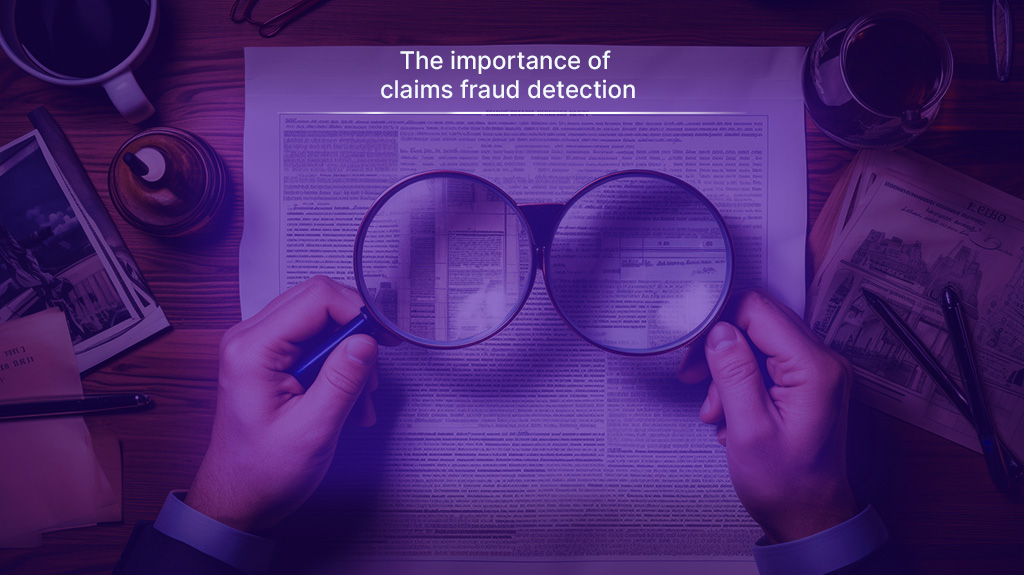Insurance fraud is a serious problem plaguing the insurance industry. In fact, the Coalition Against Insurance Fraud estimates that U.S consumers incur $80 billion in annual insurance fraud costs. Non-health insurance accounts for over $40 billion of the total cost of insurance fraud, according to an FBI report. This means that an average American family incurs costs of between $400 and $700 annually in increased premiums due to insurance fraud. Fortunately, advanced insurance technologies such as insurance fraud detection software help insurers stay one step ahead of insurance fraud perpetrators.
Introduction to Insurance Fraud Detection Software: What It Is and How It Works
With features such as artificial intelligence, machine learning, and predictive data modeling and analytics, insurance fraud detection software enables insurers to see the invisible warning signs of insurance claim fraud.
Here's a look at how these solutions can help insurers identify insurance claim fraud.
1. Access to Large Amounts of Raw Data
The insurance industry has historically collected large volumes of data. But it has been slow to leverage it to improve various processes. Today, there's a wide range of customer data that can be useful in the claim fraud detection process, including social, real-time, and historical data that's not only about them but also about the specific scenario they are in.
Insurance fraud detection software enables insurers to gather and access large volumes of customer data better than before. When insurance systems analyze these data sets, they can identify signs of insurance fraud on claims. For instance, by leveraging voice analytics on a voice recording of a claim submission, insurers can detect how nervous someone is when submitting their claim.
That said, as first movers in the insurance industry adopt AI and ML solutions to harness the potential of their data, insurers who are slow to adopt these solutions will lag behind.
2. Behavioral Pattern Recognition
Various types of insurance fraud, such as 'crash for cash,' are often difficult to detect. Insurers need to invest a lot of money, time, and effort to detect such fraud. AI-based insurance fraud claim detection solutions can cross-reference and analyze various data points, thereby simplifying insurance fraud detection.
ML models can also identify similarities that exist between previous fraudulent activities. Carriers can classify each activity as either fraudulent or non-fraudulent. Over time, ML also determines the parameters that indicate a dubious claim and subjects them to further investigation.
Carriers can also leverage behavioral analytics to combat insurance fraud. Behavioral analytics offers insights into policyholders' actions by monitoring and interpreting their behavior patterns. It, therefore, helps insurers determine whether a policyholder's claim is genuine. Behavioral analytics can prevent inflated claims where fraud perpetrators attempt to include the cost of previous damages to a new claim. Behavioral analytics also comes in handy in preventing false claims that result from a fraudster altering data because they know that their insurance policy doesn't cover the actual scenario.
3. Assessing Loss Using Computer Vision
When processing a client's claim, insurers run the risk of negatively affecting customer satisfaction by conducting lengthy investigations or delaying payouts. At the same time, incorrect payouts can reduce an insurer's profitability.
Insurance fraud detection software balances loss avoidance and the cost of dubious insurance claims. It does this by leveraging computer vision and ML to enable fraud detection algorithms that factor in past experiences. For example, computer vision models can identify and alert insurers on specific elements of a claim, such as forged images or invalid documents. Computer vision models can also enhance the accuracy of forecasts, enabling insurance loss control departments to cover more cases with fewer false positives.
In short, these solutions enable insurers to assess damages more accurately, thereby preventing inflated repair claims.
4. Claim Notification With IoT

The numerous benefits insurers get from IoT devices have led to the explosive growth of the insurance IoT market.According to Allied Market Research, the global IoT insurance market is projected to hit the $304.31 billion mark by 2027.
One of the primary use cases of IoT in insurance is in the claims management process. Previously, insurers relied on policyholder reports. In most cases, these reports were subjective. With IoT devices, insurers receive real-time alerts of claims. For instance, in case of a car accident, the insurer will instantly receive a claim notification without the policyholder contacting them. Because of this, claims processing begins immediately after the damage occurs, affording fraudsters limited time to alter data.
Additionally, insurance providers can leverage IoT to contrast a policyholder's data in the first notice of loss (FNOL) regarding time, location, the speed at which the car was moving, etc., with the information available in the vehicle's smart memory.
5. Speeding Up Claim Processing With Chatbots
Before the emergence of AI/ML models, claim processing was carried out manually. Consequently, insurers spent a lot of time conducting the process, giving insurance fraud perpetrators too much time to alter data in their favor.
All this has changed with the emergence of insurance claim chatbots. Today, policyholders can submit FNOLs using the instructions given by the chatbot. The initial stages of claim processing are completed immediately without the intervention of a human insurance expert. By enabling faster claim processing, chatbots ensure that fraudsters have less time to alter data. As such, it helps reduce the losses from insurance claim fraud.
6. Preventing Double-Dipping Using Blockchain Technology
Blockchain technology records transactional data in real-time while at the same time addressing control, privacy, and any security concerns. It can also come in handy in preventing the approval of repeated transactions for the same claim. Only the claim with the most approvals will be regarded as being valid; the rest will be dismissed.
Mitigate Fraud by Quickly Identifying Suspicious Claims Through Insurance Fraud Detection Software
Given the increase in the frequency and complexity of insurance fraud claims, carriers need to adopt the use of fraud analytics insurance solutions. Pilotbird's AI-powered analytics solution is designed to combat insurance fraud at inception with early detection and prevention. Get started with Pilotbird's fraud analytics insurance solutions today.
Sources
- Allied Market Research. IoT Insurance Market. https://www.alliedmarketresearch.com/iot-insurance-market-A09784
- Coalition Against Insurance Fraud. https://insurancefraud.org/fraud-stats/
- FBI Insurance Reports and Publications. https://www.fbi.gov/stats-services/publications/insurance-fraud
- Gencer, G. (2022, May 11). 5 Technologies Improving Insurance Fraud Detection. https://research.aimultiple.com/insurance-fraud-detection/
- Insurance Fraud Bureau. Crash for Cash. https://insurancefraudbureau.org/insurance-fraud/crash-for-cash/
- Payoda Technology Inc. (2021, August 22). Role of AI and ML in Insurance Fraud Detection. https://medium.com/codex/role-of-ai-and-ml-in-insurance-fraud-detection-5c363d10def
- Shakeel, F. (2022, April 13). Artificial Intelligence-Based Fraud Detection in Insurance Claim Process. https://www.damcogroup.com/blogs/artificial-intelligence-based-fraud-detection-in-insurance-claims-process





Leave a Comment
Your email address will not be published. Required fields are marked *